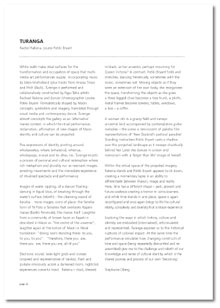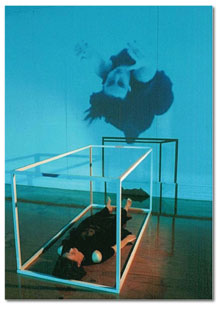 |
|||||||||
|
|
| ...Publications: Annual | ...The Physics Room Annual 2002 | ||||||||||||||
|
TURANGA White walls make ideal surfaces for the transformation and occupation of space that multimedia art performances supply. Incorporating music by Eden Mulholland (plus tracks from Ariana Tikao and Pitch Black), Turanga is performed and collaboratively constructed by Ngai Tahu artists Rachael Rakena and dancer /choreographer Louise Potiki Bryant. Formalistically shaped by Maori concepts, symbolism and imagery, translated through visual media and contemporary dance, Turanga almost conscripts the gallery as an ‘alternative’ marae context, in which the ritual performance, reclamation, affirmation of new shapes of Maori identity and culture can be projected. Five expressions of identity pivoting around whakawatea, whare (wharenui), whenua, whakapapa, marae and ko ahau nei, Turanga enacts a process of personal and cultural redemption where rich metaphors and plurality run as resonant images, arresting movements and the immediate experience of ritualised spectacle and performance. Images of water rippling, of a dancer floating-dancing in liquid blue, of breaking through the water’s surface (rebirth) - the cleansing sound of karakia... more images, icons of place- the familiar form of Te Poto a Tamatea that overlooks Rapaki marae (Banks Peninsula), the marae itself. Laughter from a community of brown faces as Rapaki is described in Maori as ”the centre of the universe”, laughter again at the notion of Maori in literal translation- “dining room standing there- tis you, tis you, tis you”... “therefore, there you are, there you are, there you are, all of you”. Electronic sound, laser-light grids and crosses (inspired and representative of taniko), flash and pulsate ominously across a darkened room, nightclub experiences come to mind. Rakena - staid, dressed in black, as her ancestor, perhaps mourning for Queen Victoria? In contrast, Potiki Bryant folds and stretches, dancing frenetically, sometimes with the music, sometimes not. Moving objects as if they were an extension of her own body, she reorganises the space, transforming the objects as she goes; a three legged chair becomes a tree trunk, a plinth, metal frames become screens, tables, windows, a box - a coffin. A woman sits in a grassy field and surveys ancestral land accompanied by contemplative guitar melodies - the scene is reminiscent of pakeha film representations of ‘New Zealand’s pastoral paradise’. Standing motionless Potiki Bryant casts a shadow over the projected landscape as it sweeps chaotically behind her. Later she dances in unison and memoriam with a ‘larger than life’ image of herself. Within the virtual space of the projected imagery, Rakena stands and Potiki Bryant appears to sit down, creating a momentary lapse in an ability to differentiate between illusion, image and reality. Here, time has a different shape - past, present and future coalesce creating a tremor in consciousness, and while time stands in one place, space is again reconfigured and once again brings to life the cultural vitality, complexity and diversity that is Maori experience. Exploring the ways in which history, culture and identity are embodied (internalised), reformulated and represented, Turanga exposes us to the historical ruptures of colonial impact. At the same time the performance simulates how changing constructs of time and space (being repeatedly dismantled and reassembled) give rise to the challenge and rebirth of our knowledge and sense of cultural identity, which is the shared journey and process of our own ‘becoming’. Stephanie Oberg This essay originally appeared in The Physics Room Annual 2002 Order your copy today from The
Physics Room ! Related Turanga.
|
||||||||||||||


